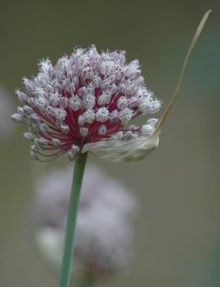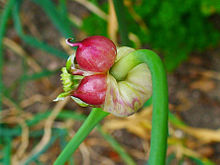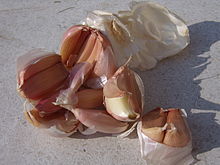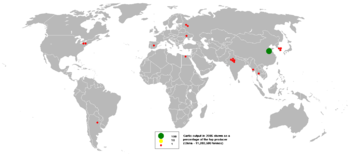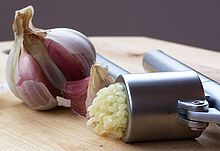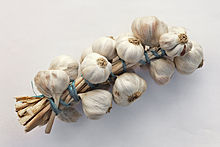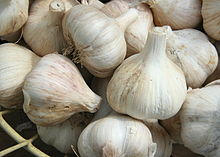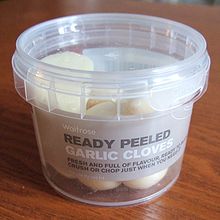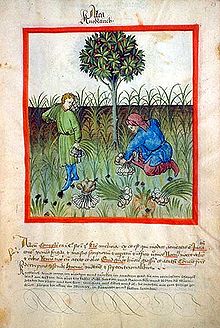
Garlic
Background Information
SOS believes education gives a better chance in life to children in the developing world too. See http://www.soschildren.org/sponsor-a-child to find out about child sponsorship.
| Garlic | |
|---|---|
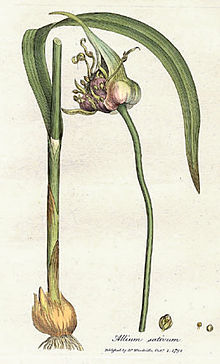 |
|
| Allium sativum, known as garlic, from William Woodville, Medical Botany, 1793. | |
| Scientific classification |
|
| Kingdom: | Plantae |
| Clade: | Angiosperms |
| Clade: | Monocots |
| Order: | Asparagales |
| Family: | Amaryllidaceae |
| Subfamily: | Allioideae |
| Genus: | Allium |
| Species: | A. sativum |
| Binomial name | |
| Allium sativum L. |
|
Allium sativum, commonly known as garlic, is a species in the onion genus, Allium. Its close relatives include the onion, shallot, leek, chive, and rakkyo. With a history of human use of over 7,000 years, garlic is native to central Asia, and has long been a staple in the Mediterranean region, as well as a frequent seasoning in Asia, Africa, and Europe. It was known to Ancient Egyptians, and has been used for both culinary and medicinal purposes.
Description
Allium sativum is a bulbous plant. It grows up to 0.6 m (2 ft) in height. Its hardiness is USDA Zone 8. It produces hermaphrodite flowers. Pollination occurs by insects and bees.
Origin and major types
According to Zohary and Hopf, "A difficulty in the identification of its wild progenitor is the sterility of the cultivars", though it is thought to be descended from the species Allium longicuspis, which grows wild in central and southwestern Asia. Allium sativum grows in the wild in areas where it has become naturalized. The "wild garlic", "crow garlic", and " field garlic" of Britain are members of the species Allium ursinum, Allium vineale, and Allium oleraceum, respectively. In North America, Allium vineale (known as "wild garlic" or "crow garlic") and Allium canadense, known as "meadow garlic" or "wild garlic" and "wild onion", are common weeds in fields. One of the best-known "garlics", the so-called elephant garlic, is actually a wild leek ( Allium ampeloprasum), and not a true garlic. Single clove garlic (also called pearl or solo garlic) originated in the Yunnan province of China.
European garlic
There are a number of garlics with Protected Geographical Status in Europe; these include:
- Aglio Rosso di Nubia (Red Garlic of Nubia) from Nubia-Paceco, Provincia di Trapani, Sicily, Italy
- Aglio Bianco Polesano from Veneto, Italy (PDO)
- Aglio di Voghiera from Ferrara, Emilia-Romagna, Italy (PDO)
- Ail blanc de Lomagne from Lomagne in the Gascony area of France (PGI)
- Ail de la Drôme from Drôme in France (PGI)
- Ail rose de Lautrec a rose/pink garlic from Lautrec in France (PGI)
- Ajo Morado de las Pedroñeras a rose/pink garlic from Las Pedroñeras in Spain (PGI)
Varieties
Within the species, Allium sativum, there are also two main subspecies or varieties.
- Allium sativum var. ophioscorodon (Link) Döll, called Ophioscorodon, or hard necked garlic, includes porcelain garlics, rocambole garlic, and purple stripe garlics. It is sometimes considered to be a separate species, Allium ophioscorodon G.Don.
- Allium sativum var. sativum, or soft-necked garlic, includes artichoke garlic, silverskin garlic, and creole garlic.
Bulb garlic is available in many forms, including fresh, frozen, dried, fermented (black garlic) and shelf stable products (in tubes or jars). In addition, see Culinary uses for other edible parts of the garlic plant.
Cultivation
Garlic is easy to grow and can be grown year-round in mild climates. While sexual propagation of garlic is indeed possible, nearly all of the garlic in cultivation is propagated asexually, by planting individual cloves in the ground. In cold climates, cloves are planted in the fall, about six weeks before the soil freezes, and harvested in late spring. The cloves must be planted at minimum 4 inches underground to prevent freeze/thaw which causes mold or white rot Garlic plants are usually very hardy, and are not attacked by many pests or diseases. Garlic plants are said to repel rabbits and moles. Two of the major pathogens that attack garlic are nematodes and white rot disease, which remain in the soil indefinitely after the ground has become infected. Garlic also can suffer from pink root, a typically nonfatal disease that stunts the roots and turns them pink or red.
Garlic plants can be grown closely together, leaving enough space for the bulbs to mature, and are easily grown in containers of sufficient depth. Garlic does well in loose, dry, well drained soils in sunny locations, and is hardy throughout USDA climate zones 4 - 9. When selecting garlic for planting, it is important to pick large heads from which to separate cloves. Large cloves, along with proper spacing in the planting bed, will also improve head size. Garlic plants prefer to grow in a soil with a high organic material content, but are capable of growing in a wide range of soil conditions and pH levels.
There are different types or subspecies of garlic, most notably hardneck garlic and softneck garlic. The latitude where the garlic is grown affects the choice of type as garlic can be day-length sensitive. Hardneck garlic is generally grown in cooler climates; softneck garlic is generally grown closer to the equator.
Garlic scapes are removed to focus all the garlic's energy into bulb growth. The scapes can be eaten raw or cooked.
Production trends
Garlic is grown globally, but China is by far the largest producer of garlic, with approximately 10.5 million tonnes (23 billion pounds) grown annually, accounting for over 77% of world output. India (4.1%) and South Korea (2%) follow, with Egypt and Russia (1.6%) tied in fourth place and the United States (where garlic is grown in every state except for Alaska) in sixth place (1.4%). This leaves 16% of global garlic production in countries that each produce less than 2% of global output. Much of the garlic production in the United States is centered in Gilroy, California, which calls itself the "garlic capital of the world".
| Top 10 garlic producers in 2010 | ||||
|---|---|---|---|---|
| Country | Production ( tonnes) | Footnote | ||
| 13,664,069 | Im | |||
| 833,970 | ||||
| 271,560 | ||||
| 244,626 | ||||
| 213,480 | ||||
| 185,900 | Im | |||
| 180,300 | Im | |||
| 169,510 | ||||
| 164,392 | ||||
| 157,400 | ||||
| World | 17,674,893 | A | ||
| * = Unofficial figure | [ ] = Official data | A = May include official, semi-official or estimated data F = FAO estimate | Im = FAO data based on imputation methodology | M = Data not available Source: UN Food & Agriculture Organisation (FAO) |
||||
Uses
Culinary uses
Garlic is widely used around the world for its pungent flavor as a seasoning or condiment.
The garlic plant's bulb is the most commonly used part of the plant. With the exception of the single clove types, garlic bulbs are normally divided into numerous fleshy sections called cloves. Garlic cloves are used for consumption (raw or cooked) or for medicinal purposes. They have a characteristic pungent, spicy flavor that mellows and sweetens considerably with cooking.
Other parts of the garlic plant are also edible. The leaves and flowers ( bulbils) on the head ( spathe) are sometimes eaten. They are milder in flavor than the bulbs, and are most often consumed while immature and still tender. Immature garlic is sometimes pulled, rather like a scallion, and sold as "green garlic". When green garlic is allowed to grow past the "scallion" stage, but not permitted to fully mature, it may produce a garlic "round", a bulb like a boiling onion, but not separated into cloves like a mature bulb. Additionally, the immature flower stalks ( scapes) of the hardneck and elephant types are sometimes marketed for uses similar to asparagus in stir-fries.
Inedible or rarely eaten parts of the garlic plant include the "skin" and root cluster. The papery, protective layers of "skin" over various parts of the plant are generally discarded during preparation for most culinary uses, though in Korea immature whole heads are sometimes prepared with the tender skins intact. The root cluster attached to the basal plate of the bulb is the only part not typically considered palatable in any form.
Garlic is a fundamental component in many or most dishes of various regions, including eastern Asia, South Asia, Southeast Asia, the Middle East, northern Africa, southern Europe, and parts of South and Central America. The flavour varies in intensity and aroma with the different cooking methods. It is often paired with onion, tomato, or ginger. The parchment-like skin is much like the skin of an onion, and is typically removed before using in raw or cooked form. An alternative is to cut the top off the bulb, coat the cloves by dribbling olive oil (or other oil-based seasoning) over them, and roast them in an oven. Garlic softens and can be extracted from the cloves by squeezing the (root) end of the bulb, or individually by squeezing one end of the clove. In Korea, heads of garlic are fermented at high temperature; the resulting product, called black garlic, is sweet and syrupy, and is now being sold in the United States, United Kingdom and Australia.
Garlic may be applied to different kinds of bread to create a variety of classic dishes, such as garlic bread, garlic toast, bruschetta, crostini and canapé.
Oils can be flavored with garlic cloves. These infused oils are used to season all categories of vegetables, meats, breads and pasta.
In some cuisines, the young bulbs are pickled for three to six weeks in a mixture of sugar, salt, and spices. In eastern Europe, the shoots are pickled and eaten as an appetizer.
Immature scapes are tender and edible. They are also known as "garlic spears", "stems", or "tops". Scapes generally have a milder taste than the cloves. They are often used in stir frying or braised like asparagus. Garlic leaves are a popular vegetable in many parts of Asia. The leaves are cut, cleaned, and then stir-fried with eggs, meat, or vegetables.
Mixing garlic with egg yolks and olive oil produces aioli. Garlic, oil, and a chunky base produce skordalia. Blending garlic, almond, oil, and soaked bread produces ajoblanco.
Garlic powder has a different taste from fresh garlic. If used as a substitute for fresh garlic, 1/8 teaspoon of garlic powder is equivalent to one clove of garlic.
Storage
Domestically, garlic is stored warm [above 18 °C (64 °F)] and dry to keep it dormant (so it does not sprout). It is traditionally hung; softneck varieties are often braided in strands called plaits or grappes. Peeled cloves may be stored in wine or vinegar in the refrigerator. Commercially, garlic is stored at 0 °C (32 °F), in a dry, low- humidity environment. Garlic will keep longer if the tops remain attached.
Garlic is often kept in oil to produce flavoured oil; however, the practice requires measures to be taken to prevent the garlic from spoiling. Untreated garlic kept in oil can support the growth of Clostridium botulinum which causes the deadly botulism illness; refrigeration will not assure the safety of garlic kept in oil. To reduce this risk, the oil should be refrigerated and used within one week. Commercially prepared oils are widely available. Manufacturers add acids and/or other chemicals to eliminate the risk of botulism in their products. Two outbreaks of botulism related to garlic stored in oil have been reported.
In 1961, Chester Lilley from Kent in England was the first person to transform garlic into a pill form for storage. Although not widely accepted at the time for culinary uses, a capsulate solution for both the storage and simple dosing of garlic has become commonplace.
Historical use
Garlic has been used as both food and medicine in many cultures for thousands of years, dating at least as far back as when the Giza pyramids were built. Garlic is still grown in Egypt, but the Syrian variety is the kind most esteemed now (see Rawlinson's Herodotus, 2.125).
Hippocrates, Galen, Pliny the Elder, and Dioscorides all mention the use of garlic for many conditions, including parasites, respiratory problems, poor digestion, and low energy. Its use in China dates back to 2000 BCE.
It was consumed by ancient Greek and Roman soldiers, sailors, and rural classes (Virgil, Ecologues ii. 11), and, according to Pliny the Elder ( Natural History xix. 32), by the African peasantry. Galen eulogizes it as the "rustic's theriac" (cure-all) (see F. Adams' Paulus Aegineta, p. 99), and Alexander Neckam, a writer of the 12th century (see Wright's edition of his works, p. 473, 1863), recommends it as a palliative for the heat of the sun in field labor.
In the account of Korea's establishment as a nation, a tiger and a bear prayed to Hwanung that they may become human. Upon hearing their prayers, Hwanung gave them 20 cloves of garlic and a bundle of mugwort, ordering them to eat only this sacred food and remain out of the sunlight for 100 days. The tiger gave up after about twenty days and left the cave. However, the bear remained and was transformed into a woman.
In his Natural History, Pliny gives an exceedingly long list of scenarios in which it was considered beneficial (N.H. xx. 23). Dr. T. Sydenham valued it as an application in confluent smallpox, and, says Cullen (Mat. Med. ii. p. 174, 1789), found some dropsies cured by it alone. Early in the 20th century, it was sometimes used in the treatment of pulmonary tuberculosis or phthisis.
Garlic was rare in traditional English cuisine (though it is said to have been grown in England before 1548) and has been a much more common ingredient in Mediterranean Europe. Garlic was placed by the ancient Greeks on the piles of stones at crossroads, as a supper for Hecate ( Theophrastus, Characters, The Superstitious Man). A similar practice of hanging garlic, lemon and red chilli at the door or in a shop to ward off potential evil, is still very common in India. According to Pliny, garlic and onions were invoked as deities by the Egyptians at the taking of oaths. (Pliny also stated garlic demagnetizes lodestones, which is not factual.) The inhabitants of Pelusium, in lower Egypt (who worshiped the onion), are said to have had an aversion to both onions and garlic as food.
To prevent the plant from running to leaf, Pliny (N.H. xix. 34) advised bending the stalk downward and covering with earth; seeding, he observes, may be prevented by twisting the stalk (by "seeding", he most likely meant the development of small, less potent bulbs).
Medicinal use and health benefits
| Nutritional value per 100 g (3.5 oz) | |
|---|---|
| Energy | 623 kJ (149 kcal) |
| Carbohydrates | 33.06 g |
| - Sugars | 1 g |
| - Dietary fibre | 2.1 g |
| Fat | 0.5 g |
| Protein | 6.36 g |
| Thiamine (vit. B1) | 0.2 mg (17%) |
| Riboflavin (vit. B2) | 0.11 mg (9%) |
| Niacin (vit. B3) | 0.7 mg (5%) |
| Pantothenic acid (B5) | 0.596 mg (12%) |
| Vitamin B6 | 1.235 mg (95%) |
| Folate (vit. B9) | 3 μg (1%) |
| Vitamin C | 31.2 mg (38%) |
| Calcium | 181 mg (18%) |
| Iron | 1.7 mg (13%) |
| Magnesium | 25 mg (7%) |
| Manganese | 1.672 mg (80%) |
| Phosphorus | 153 mg (22%) |
| Potassium | 401 mg (9%) |
| Sodium | 17 mg (1%) |
| Zinc | 1.16 mg (12%) |
| Selenium | 14.2 μg |
| Link to USDA Database entry Percentages are relative to US recommendations for adults. Source: USDA Nutrient Database |
|
Garlic is claimed to help prevent heart disease (including atherosclerosis, high cholesterol, and high blood pressure) and cancer. Animal studies, and some early research studies in humans, have suggested possible cardiovascular benefits of garlic. A Czech study found garlic supplementation reduced accumulation of cholesterol on the vascular walls of animals. Another study had similar results, with garlic supplementation significantly reducing aortic plaque deposits of cholesterol-fed rabbits. Another study showed supplementation with garlic extract inhibited vascular calcification in human patients with high blood cholesterol. The known vasodilative effect of garlic is possibly caused by catabolism of garlic-derived polysulfides to hydrogen sulfide in red blood cells (RBCs), a reaction that is dependent on reduced thiols in or on the RBC membrane. Hydrogen sulfide is an endogenous cardioprotective vascular cell-signaling molecule.
A randomized clinical trial funded by the National Institutes of Health (NIH) in the United States and published in the Archives of Internal Medicine in 2007 found the consumption of garlic in any form did not reduce blood cholesterol levels in patients with moderately high baseline cholesterol levels. According to Heart.org, "despite decades of research suggesting that garlic can improve cholesterol profiles, a new NIH-funded trial found absolutely no effects of raw garlic or garlic supplements on LDL, HDL, or triglycerides... The findings underscore the hazards of meta-analyses made up of small, flawed studies and the value of rigorously studying popular herbal remedies". In an editorial regarding the initial report's findings, two physicians from Weill Cornell Medical College of Cornell University, pointed out that there may "be effects of garlic on atherosclerosis specifically that were not picked up in the study".
However, a 2012 meta-analysis of randomized, double-blind, placebo-controlled trials looking at the effects of garlic on serum lipid profiles, found garlic was superior to placebo in reducing serum total cholesterol and triglyceride levels. Compared with the placebo groups, serum total cholesterol and triglyceride levels in the garlic groups was reduced by 0.28 (95% CI, -0.45, -0.11) mmol L⁻¹ (P = 0.001) and 0.13 (95% CI, -0.20, -0.06) mmol L⁻¹ (P < 0.001), respectively.
Allium sativum has been found to reduce platelet aggregation and hyperlipidemia.
In 2007, the BBC reported Allium sativum may have other beneficial properties, such as preventing and fighting the common cold. This assertion has the backing of long tradition in herbal medicine, which has used garlic for hoarseness and coughs. The Cherokee also used it as an expectorant for coughs and croup. However, in contrast to these earlier claims concerning the cold-preventing properties of garlic, a 2012 report in the Cochrane Database of Systematic Reviews concludes that "there is insufficient clinical trial evidence regarding the effects of garlic in preventing or treating the common cold. A single trial suggested that garlic may prevent occurrences of the common cold but more studies are needed to validate this finding. Claims of effectiveness appear to rely largely on poor-quality evidence."
Garlic is also alleged to help regulate blood sugar levels. Regular and prolonged use of therapeutic amounts of aged garlic extracts lower blood homocysteine levels and has been shown to prevent some complications of diabetes mellitus. People taking insulin should not consume medicinal amounts of garlic without consulting a physician.
Garlic was used as an antiseptic to prevent gangrene during World War I and World War II. More recently, it has been found from a clinical trial that a mouthwash containing 2.5% fresh garlic shows good antimicrobial activity, although the majority of the participants reported an unpleasant taste and halitosis.
Garlic cloves are used as a remedy for infections (especially chest problems), digestive disorders, and fungal infections such as thrush. Garlic can be used as a disinfectant because of its bacteriostatic and bacteriocidal properties.
Garlic has been found to enhance thiamin absorption, and therefore reduces the likelihood for developing the thiamin deficiency beriberi.
In 1924, it was found to be an effective way to prevent scurvy, because of its high vitamin C content.
Garlic has been used reasonably successfully in AIDS patients to treat Cryptosporidium in an uncontrolled study in China. It has also been used by at least one AIDS patient to treat toxoplasmosis, another protozoal disease.
Garlic supplementation has been shown to boost testosterone levels in rats fed a high protein diet.
A 2010 double-blind, parallel, randomised, placebo-controlled trial, involving 50 patients whose routine clinical records in general practice documented treated but uncontrolled hypertension, concluded, "Our trial suggests that aged garlic extract is superior to placebo in lowering systolic blood pressure similarly to current first line medications in patients with treated but uncontrolled hypertension."
Other uses
The sticky juice within the bulb cloves is used as an adhesive in mending glass and porcelain. An environmentally benign garlic-derived polysulfide product is approved for use in the European Union (under Annex 1 of 91/414) and the UK as a nematicide and insecticide, including for use for control of cabbage root fly and red mite in poultry.
Adverse effects and toxicology
Garlic is known for causing bad breath ( halitosis), as well as causing sweat to have a pungent "garlicky" smell, which is caused by allyl methyl sulfide (AMS). AMS is a volatile liquid which is absorbed into the blood during the metabolism of garlic-derived sulfur compounds; from the blood it travels to the lungs (and from there to the mouth, causing bad breath; see garlic breath) and skin, where it is exuded through skin pores. Washing the skin with soap is only a partial and imperfect solution to the smell. Studies have shown sipping milk at the same time as consuming garlic can significantly neutralize bad breath. Mixing garlic with milk in the mouth before swallowing reduced the odor better than drinking milk afterward. Plain water, mushrooms and basil may also reduce the odour; the mix of fat and water found in milk, however, was the most effective.
The green, dry "folds" in the centre of the garlic clove are especially pungent. The sulfur compound allicin, produced by crushing or chewing fresh garlic, produces other sulfur compounds: ajoene, allyl polysulfides, and vinyldithiins. Aged garlic lacks allicin, but may have some activity due to the presence of S-allylcysteine.
In a rat study allicin was found to be an activator of TRPA1. The neurons released neurotransmitters in the spinal cord to generate pain signals and released neuropeptides at the site of sensory nerve activation, resulting in vasodilation, as well as inflammation. Allicin is released only by crushing or chewing raw garlic and cannot be formed from cooked garlic.
Some people suffer from allergies to garlic and other plants in the allium genus. Symptoms can include irritable bowel, diarrhea, mouth and throat ulcerations, nausea, breathing difficulties, and, in rare cases, anaphylaxis. Garlic-sensitive patients show positive tests to diallyl disulfide, allylpropyldisulfide, allylmercaptan and allicin, all of which are present in garlic. People who suffer from garlic allergies will often be sensitive to many plants, including onions, garlic, chives, leeks, shallots, garden lilies, ginger, and bananas.
Garlic reduces platelet aggregation (as does aspirin); this had caused very high quantities of garlic and garlic supplements to be linked with an increased risk of bleeding, particularly during pregnancy and after surgery and childbirth, although culinary quantities are safe for consumption.
Several reports of serious burns resulting from garlic being applied topically for various purposes, including naturopathic uses and acne treatment, indicate care must be taken for these uses, usually testing a small area of skin using a very low concentration of garlic. On the basis of numerous reports of such burns, including burns to children, topical use of raw garlic, as well as insertion of raw garlic into body cavities, is discouraged. In particular, topical application of raw garlic to young children is not advisable. The side effects of long-term garlic supplementation, if any exist, are largely unknown, and no FDA-approved study has been performed. However, garlic has been consumed for several thousand years without any adverse long-term effects, suggesting modest quantities of garlic pose, at worst, minimal risks to normal individuals. Possible side effects include gastrointestinal discomfort, sweating, dizziness, allergic reactions, bleeding, and menstrual irregularities. The safety of garlic supplements has not been determined for children; some breastfeeding mothers have found their babies slow to feed and have noted a garlic odour coming from their baby when they have consumed garlic.
Garlic may interact with warfarin, antiplatelets, saquinavir, antihypertensives, calcium channel blockers, quinolone family of antibiotics such as Cipro,and hypoglycemic drugs, as well as other medications. Members of the alium family might be toxic to cats or dogs. Some degree of liver toxicity has been demonstrated in rats, particularly in extremely large quantities exceeding those that a rat would consume under normal situations.
Spiritual and religious uses
Garlic has been regarded as a force for both good and evil. According to Cassell's Dictionary of Superstitions, there is an Islamic myth that considers that after Satan left the Garden of Eden, garlic arose in his left footprint and onion in the right. In Europe, many cultures have used garlic for protection or white magic, perhaps owing to its reputation as a potent preventative medicine. Central European folk beliefs considered garlic a powerful ward against demons, werewolves, and vampires. To ward off vampires, garlic could be worn, hung in windows, or rubbed on chimneys and keyholes.
In both Hinduism and Jainism, garlic is considered to stimulate and warm the body and to increase one's desires. Some devout Hindus generally avoid using garlic and the related onion in the preparation of foods for religious festivities and events. Followers of the Jain religion avoid eating garlic and onion on a daily basis.
A belief among some Hindus is that when Devas and Asuras fought for nectar during churning of the ocean of milk (Samudramathan) in the other world, two Asuras were able to get access to nectar and had some quantity in their mouths in stealthy ways. Knowing the Asuras' foul play the God cuffed the heads of those Asuras before they could swallow it and as a result nectar fell down on the earth from their mouths in drops which later grew as garlic; that is why the vegetable has such wonderful medicinal properties.
In some Buddhist traditions, garlic - along with the other five "pungent spices" - is understood to stimulate sexual and aggressive drives to the detriment of meditation practice.
Properties
When crushed, Allium sativum yields allicin, an antibiotic and antifungal compound ( phytoncide) discovered by Chester J. Cavallito and colleagues in 1944. Fresh or crushed garlic also affords the sulfur-containing compounds alliin, ajoene, diallyl polysulfides, vinyldithiins, S- allylcysteine, and enzymes, B vitamins, proteins, minerals, saponins, flavonoids, and Maillard reaction products, which are not sulfur-containing compounds. Furthermore, a phytoalexin ( allixin) was found, a nonsulfur compound with a γ- pyrone skeleton structure with antioxidant effects, antimicrobial effects, antitumor promoting effects, inhibition of aflatoxin B2 DNA binding, and neurotrophic effects. Allixin showed an antitumor promoting effect in vivo, inhibiting skin tumor formation by TPA and DMBA initiated mice. Analogs of this compound have exhibited antitumor promoting effects in in vitro experimental conditions. Herein, allixin and/or its analogs may be expected useful compounds for cancer prevention or chemotherapy agents for other diseases.
The composition of the bulbs is approximately 84.09% water, 13.38% organic matter, and 1.53% inorganic matter, while the leaves are 87.14% water, 11.27% organic matter, and 1.59% inorganic matter.
The phytochemicals responsible for the sharp flavor of garlic are produced when the plant's cells are damaged. When a cell is broken by chopping, chewing, or crushing, enzymes stored in cell vacuoles trigger the breakdown of several sulfur-containing compounds stored in the cell fluids ( cytosol). The resultant compounds are responsible for the sharp or hot taste and strong smell of garlic. Some of the compounds are unstable and continue to react over time. Among the members of the onion family, garlic has by far the highest concentrations of initial reaction products, making garlic much more potent than onion, shallot, or leeks. Although many humans enjoy the taste of garlic, these compounds are believed to have evolved as a defensive mechanism, deterring animals such as birds, insects, and worms from eating the plant.
A large number of sulfur compounds contribute to the smell and taste of garlic. Allicin has been found to be the compound most responsible for the "hot" sensation of raw garlic. This chemical opens thermo transient receptor potential channels that are responsible for the burning sense of heat in foods. The process of cooking garlic removes allicin, thus mellowing its spiciness. Allicin, along with its decomposition products diallyl disulfide and diallyl trisulfide, are major contributors to the characteristic odour of garlic, while other allicin-derived compounds, such as vinyldithiins and ajoene show beneficial in vitro biological activity. Because of its strong odour, garlic is sometimes called the "stinking rose". When eaten in quantity, garlic may be strongly evident in the diner's sweat and garlic breath the following day. This is because garlic's strong-smelling sulfur compounds are metabolized, forming allyl methyl sulfide. Allyl methyl sulfide (AMS) cannot be digested and is passed into the blood. It is carried to the lungs and the skin, where it is excreted. Since digestion takes several hours, and release of AMS several hours more, the effect of eating garlic may be present for a long time.
This well-known phenomenon of "garlic breath" is alleged to be alleviated by eating fresh parsley. The herb is, therefore, included in many garlic recipes, such as pistou, persillade, and the garlic butter spread used in garlic bread. However, since the odour results mainly from digestive processes placing compounds such as AMS in the blood, and AMS is then released through the lungs over the course of many hours, eating parsley provides only a temporary masking. One way of accelerating the release of AMS from the body is the use of a sauna.
Because of the AMS in the bloodstream, it is believed by some to act as a mosquito repellent, but no clinically reported evidence suggests it is actually effective.
